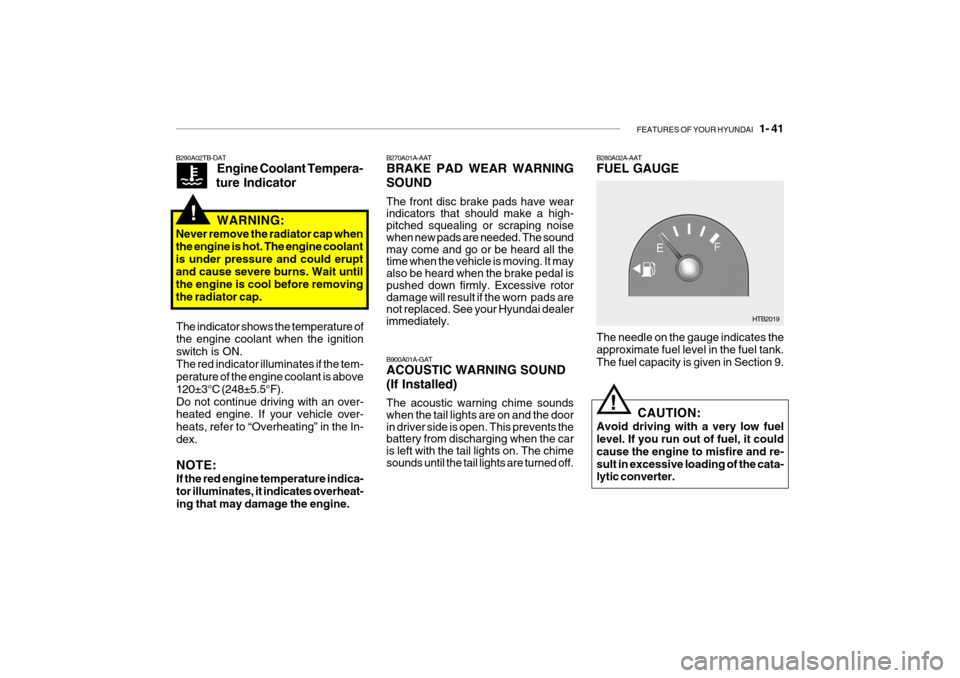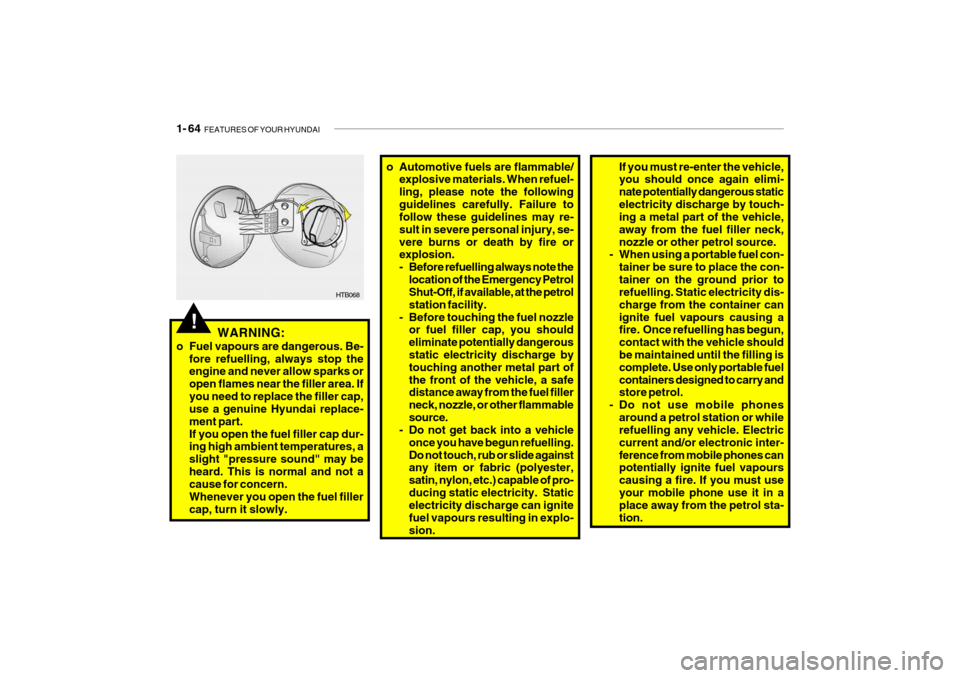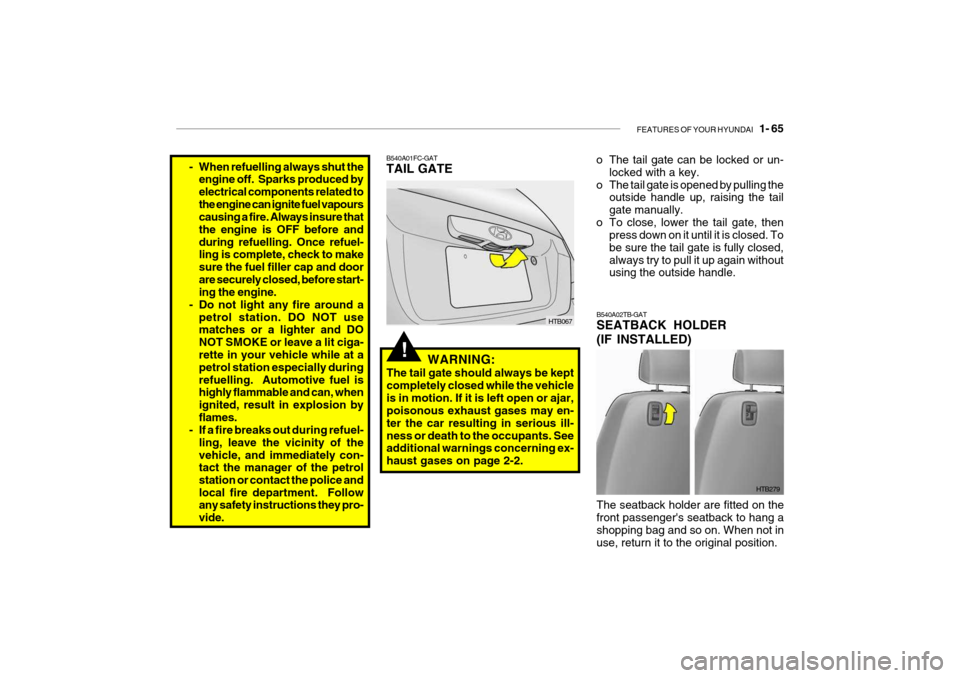2009 Hyundai Getz fuel cap
[x] Cancel search: fuel capPage 52 of 191

FEATURES OF YOUR HYUNDAI 1- 41
B270A01A-AAT BRAKE PAD WEAR WARNING SOUND The front disc brake pads have wear indicators that should make a high- pitched squealing or scraping noise when new pads are needed. The sound may come and go or be heard all the time when the vehicle is moving. It may also be heard when the brake pedal is pushed down firmly. Excessive rotor damage will result if the worn pads are not replaced. See your Hyundai dealer immediately.
B290A02TB-DAT
Engine Coolant Tempera-
ture Indicator
WARNING:
Never remove the radiator cap when the engine is hot. The engine coolantis under pressure and could erupt and cause severe burns. Wait until the engine is cool before removingthe radiator cap.
!
B900A01A-GAT ACOUSTIC WARNING SOUND (If Installed) The acoustic warning chime sounds when the tail lights are on and the door in driver side is open. This prevents the battery from discharging when the car is left with the tail lights on. The chime sounds until the tail lights are turned off.
The indicator shows the temperature of the engine coolant when the ignition switch is ON.The red indicator illuminates if the tem- perature of the engine coolant is above 120±3°C (248±5.5°F).Do not continue driving with an over- heated engine. If your vehicle over- heats, refer to “Overheating” in the In-dex. NOTE: If the red engine temperature indica- tor illuminates, it indicates overheat-ing that may damage the engine.
The needle on the gauge indicates the approximate fuel level in the fuel tank. The fuel capacity is given in Section 9.
B280A02A-AAT FUEL GAUGE
HTB2019
!CAUTION:
Avoid driving with a very low fuel level. If you run out of fuel, it could cause the engine to misfire and re-sult in excessive loading of the cata- lytic converter.
Page 75 of 191

1- 64 FEATURES OF YOUR HYUNDAI
!
HTB068
WARNING:
o Fuel vapours are dangerous. Be- fore refuelling, always stop the engine and never allow sparks or open flames near the filler area. Ifyou need to replace the filler cap, use a genuine Hyundai replace- ment part.If you open the fuel filler cap dur- ing high ambient temperatures, a slight "pressure sound" may beheard. This is normal and not a cause for concern. Whenever you open the fuel fillercap, turn it slowly. o Automotive fuels are flammable/
explosive materials. When refuel-ling, please note the followingguidelines carefully. Failure to follow these guidelines may re- sult in severe personal injury, se-vere burns or death by fire or explosion.
- Before refuelling always note the
location of the Emergency Petrol Shut-Off, if available, at the petrol station facility.
- Before touching the fuel nozzle or fuel filler cap, you shouldeliminate potentially dangerous static electricity discharge by touching another metal part ofthe front of the vehicle, a safe distance away from the fuel filler neck, nozzle, or other flammablesource.
- Do not get back into a vehicle
once you have begun refuelling.Do not touch, rub or slide against any item or fabric (polyester, satin, nylon, etc.) capable of pro-ducing static electricity. Static electricity discharge can ignite fuel vapours resulting in explo-sion. If you must re-enter the vehicle, you should once again elimi- nate potentially dangerous staticelectricity discharge by touch- ing a metal part of the vehicle, away from the fuel filler neck,nozzle or other petrol source.
- When using a portable fuel con-
tainer be sure to place the con-tainer on the ground prior to refuelling. Static electricity dis- charge from the container canignite fuel vapours causing a fire. Once refuelling has begun, contact with the vehicle should be maintained until the filling is complete. Use only portable fuelcontainers designed to carry and store petrol.
- Do not use mobile phones
around a petrol station or whilerefuelling any vehicle. Electric current and/or electronic inter-ference from mobile phones can potentially ignite fuel vapours causing a fire. If you must useyour mobile phone use it in a place away from the petrol sta- tion.
Page 76 of 191

FEATURES OF YOUR HYUNDAI 1- 65
!
B540A01FC-GAT TAIL GATE
HTB067
WARNING:
The tail gate should always be kept completely closed while the vehicleis in motion. If it is left open or ajar, poisonous exhaust gases may en- ter the car resulting in serious ill-ness or death to the occupants. See additional warnings concerning ex- haust gases on page 2-2. o The tail gate can be locked or un-
locked with a key.
o The tail gate is opened by pulling the outside handle up, raising the tailgate manually.
o To close, lower the tail gate, then press down on it until it is closed. Tobe sure the tail gate is fully closed,always try to pull it up again without using the outside handle.
- When refuelling always shut the
engine off. Sparks produced by electrical components related tothe engine can ignite fuel vapours causing a fire. Always insure that the engine is OFF before andduring refuelling. Once refuel- ling is complete, check to make sure the fuel filler cap and doorare securely closed, before start- ing the engine.
- Do not light any fire around a petrol station. DO NOT usematches or a lighter and DO NOT SMOKE or leave a lit ciga- rette in your vehicle while at a petrol station especially duringrefuelling. Automotive fuel is highly flammable and can, when ignited, result in explosion byflames.
- If a fire breaks out during refuel-
ling, leave the vicinity of thevehicle, and immediately con- tact the manager of the petrol station or contact the police andlocal fire department. Follow any safety instructions they pro- vide.
The seatback holder are fitted on the front passenger's seatback to hang ashopping bag and so on. When not in use, return it to the original position.
B540A02TB-GAT SEATBACK HOLDER (IF INSTALLED)
HTB279
Page 137 of 191

5- 4 VEHICLE MAINTENANCE REQUIREMENTS
ENGINE CONTROL SYSTEM MAINTENANCE
1 ENGINE OIL & FILTER
2 DRIVE BELT (WATER PUMP, ALTERNATOR & A/CON)
3 FUEL FILTER (MPI)
4 FUEL LINES, FUEL HOSES & CONNECTIONS
5 TIMING BELT
6 VAPOR HOSE & FUEL FILLER CAP
7 VACUUM CRANKCASE VENTILATION HOSES
8 AIR CLEANER FILTER
9 SPARK PLUGS
10 VALVE CLEARANCE (1.1 L)
F030A01A-GAT SCHEDULED MAINTENANCE The following maintenance services must be performed to assure good vehicle control and performance. Keep receipts for all vehicle services to protect your warranty.Where both mileage and time are shown, the frequency of service is determined by whichever occurs first.
NO. DESCRIPTION
105
84
R
I I 120
96
R I
R
I I I I I
90
72
R II
R
I I
R
I
7560
R
I I
60
48
R I
R
I I I I I I
45
36
R
I
R
30
24
R III I I I
15
12
R
I I
KILOMETERS X 1000 MONTHS
F030B04TB-DAT R : Replace I : Inspect and, after inspection, clean, adjust, repair or replace if necessary
Note : FOR EVERY 40,000KM: "R"
See Note
Page 140 of 191

VEHICLE MAINTENANCE REQUIREMENTS 5- 7
F060A01A-AAT
EXPLANATION OF SCHEDULED MAINTENANCE ITEMS
F060M01A-AAT
o Engine Oil and Filter
The engine oil and filter should be changed at the intervals specified in the maintenance schedule. If the car is being driven in severe conditions,more frequent oil and filter changes are required. F060B01A-AAT
o Drive Belts
Inspect all drive belts for evidence of cuts, cracks, excessive wear or oil and replace if necessary. Drive beltsshould be checked periodically for proper tension and adjusted as nec- essary. placement more frequently.
After installing a new filter, run the
engine for several minutes, and check for leaks at the connections. Fuel filters should be installed by trainedtechnicians. F060D01A-AAT
o Fuel Lines, Fuel Hoses and
Connections
Check the fuel lines, fuel hoses and connections for leakage and damage.Have a trained technician replace any damaged or leaking parts immedi- ately. F060E01A-AAT
o Timing Belt Inspect all parts related to the timing belt for damage and deformation. Replace any damaged parts immedi- ately. F060G01A-AAT
o Vapor Hose and Fuel Filler Cap The vapor hose and fuel filler cap should be inspected at those inter- vals specified in the maintenance schedule. Make sure that a new va-por hose or fuel filler cap is correctly replaced. F060F01A-AAT
o Vacuum, Crankcase Ventila-
tion Hoses
Inspect the surface of hoses for evi- dence of heat and/or mechanical dam-age. Hard and brittle rubber, crack- ing, tears, cuts, abrasions, and ex- cessive swelling indicate deteriora-tion. Particular attention should be paid to examine those hose surfaces nearest to high heat sources, such asthe exhaust manifold.Inspect the hose routing to assurethat the hoses do not come in contact with any heat source, sharp edges or moving component which might causeheat damage or mechanical wear. Inspect all hose connections, such as clamps and couplings, to make surethey are secure, and that no leaks are present. Hoses should be replaced immediately if there is any evidenceof deterioration or damage.
F060C01A-AAT
o Fuel Filter
A clogged filter can limit the speed atwhich the vehicle may be driven, dam- age the emission system and cause hard starting. If an excessive amountof foreign matter accumulates in the fuel tank, the filter may require re-
Page 147 of 191

DO-IT-YOURSELF MAINTENANCE 6- 5
G030C01FC-DAT To Check the Oil Level Before checking the oil, warm up the engine to normal operating temperature and be sure your car is parked on level ground. Turn the engine off. Wait about five minutes, then remove the dipstick, wipe it off, fully reinsert the dipstick and withdraw it again. Then note the highest level the oil has reached on the dipstick. It should be between the upper ("F") and lower ("L") range. G030D01TB-DAT Adding Oil
HTB169
If the oil level is close to or below the "L" mark, add oil until it reaches the "F" mark. To add oil:
1. Remove the oil filler cap by turning it counter clockwise.
2. Add oil, then check the level again. Do not overfill.
3. Replace the cap by turning it clock-
wise.
The distance between the "F" and "L" marks is equal to about 1.2 litre of oil.
NOTE:
o For good fuel economy, SAE 5W-
20 (5W-30), ILSAC GF-3 engine oil is preferred regardless of regionaloption and engine variation.
o If SAE 5W-20, ILSAC GF-3 engine
oil is not available, secondary rec-ommended engine oil for corre- sponding temperature range can be used.
HTB167
!WARNING:
Be very careful not to touch the radia- tor hose when checking the engine oil as it may be hot enough to burn you.
Page 175 of 191

7- 2 EMISSION CONTROL SYSTEMS
H010A01A-DAT
EMISSION CONTROL SYSTEM (If Installed)
Your Hyundai is equipped with an
emission control system to meet all ADR requirements. There are three emission control sys-
tems which are as follows.
1. Crankcase emission control sys- tem
2. Evaporative emission control sys- tem
3. Exhaust emission control system
In order to assure the proper function
of the emission control systems, it is recommended that you have your car inspected and maintained by anauthorised Hyundai dealer in accor- dance with the maintenance sched- ule in this manual. H010B01A-AAT
1. Crankcase Emission Control
System
The positive crankcase ventilation
system is employed to prevent airpollution caused by blow-by gases being emitted from the crankcase. This system supplies fresh air to thecrankcase through the air intake hose. Inside the crankcase, the fresh air mixes with blow-by gases, which thenpass through the PCV valve and into the induction system.
H010C01A-DAT
2. Evaporative Emission
Control System (If Installed)
The Evaporative Emission Control
System is designed to prevent fuel vapors from escaping into the atmo- sphere. H010D01A-DAT
3. Exhaust Emission Control
System
This system has been integrated intoa highly effective system which con- trols exhaust emissions while main-taining good vehicle performance.
Canister
While the engine is inoperative, fuel
vapors generated inside the fuel tankare absorbed and stored in the canis-ter. When the engine is running, the fuel vapors absorbed in the canister are drawn into the induction systemthrough the purge control solenoid valve. Purge Control Solenoid Valve
The purge control solenoid valve is
controlled by the ECU; when the en- gine coolant temperature is low, and during idling, it closes, so that evapo- rated fuel is not taken into the engine.After engine warm-up, during ordi- nary driving, it opens so as to intro- duce evaporated fuel to the engine.
Page 184 of 191

9- 2 VEHICLE SPECIFICATIONS
Type Wheel free play Rack stroke Oil pump type 3,825 (150.6)
1,665(65.6) 1,495(58.9) 2,455(96.7)1,450(57.1) 1,440(56.7)
Overall length Overall width Overall height (unladen) Wheel baseWheel tread J030A01TB-DAT TYREDual hydraulic with brake booster Ventilated disc Drum Cable
J010A02TB-DAT MEASUREMENT
J060A01TB-DATFUEL SYSTEMRack and pinion 0 ~ 30 mm (0 ~ 1.18 in.) 132 mm (5.20 in.) 140 mm (5.5 in.)Vane type
175/65R14, 185/55R15
Type
Front Rear
mm (in.)
J020A01TB-GAT POWER STEERING
Fuel tank Capacity Litre 45 J050A01FC-GAT BRAKE
Type Front brake type Rear brake type Parking brake
J035A01TB-DAT SPARE TYRE
Full size
Standard
Manual Power